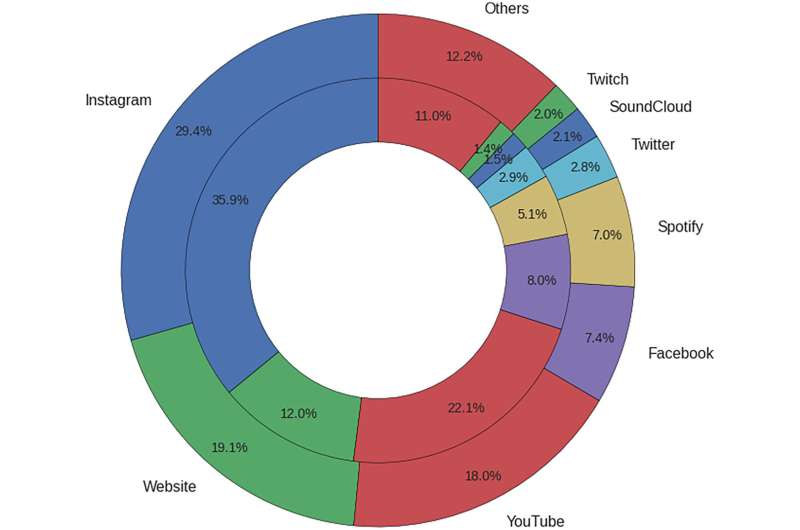Top 8 targeted platforms by services in SMM panels. The inner ring represents the percentage of different services (variations) identified. The outer ring represents the percentage of mean daily entries. Credit: Computers & Security (2022). DOI: 10.1016/j.cose.2022.103013
A study by the Universidad Carlos III de Madrid (UC3M) and IMDEA Networks analyzes fake interaction services on social media. In addition to cataloging the fraudulent ecosystem of "likes," views, followers or online visits, the study points out the economic models that sustain it and the high level of personalization that these services offer.
"There is an extensive catalog of services covered by fake interaction resale panels. You can buy any form of interaction from any global or local service," says one of the study's authors, Juan Tapiador, a professor in UC3M's Computer Science Department. Another conclusion reached by the researchers is the level of "customization" of these services.
For example, for many interactions (playing music, watching videos or "likes" on social media) you can choose the geographical origin of the account that will do so and the gender (male or female). "A third interesting finding is the disparity in prices between providers of the same service, which suggests that this is still a developing market where the market value of this service is unknown," adds Juan Tapiador.
According to the study's results, the cheapest rates include buying direct traffic to a website, getting "likes" on Instagram or getting views on multimedia platforms. For example, 1000 "likes" on Instagram cost 1.3 euros, while 2 euros can get 1,000 views on YouTube or 1,000 plays on Spotify.
Interestingly, several services are offered for free so customers can check their quality and thus be convinced to invest in different ones. This way, for less than 9 cents you can get 1,000 views on TikTok, SoundCloud or Instagram/IGTV. Buying Instagram followers is more expensive: for 4.3 euros you can get 1000. And then there are other more expensive services because they involve some personalization, such as reviews on Google or TripAdvisor, which range at around 1 euro per text.
As Narseo Vallina-Rodríguez, associate research lecturer at IMDEA Networks and another of the work's authors, says, "potential consumers of this type of service can be anyone depending on the type of review: from influencers who want to promote their channels on social media to brands trying to promote the visibility of their products."
This study, recently published in the journal Computers & Security, is part of a wider research project on the ecosystem of services that provide fake activity and identity services on the internet. The aim of this research is to quantify and analyze the evolution of the global market price of services that (re)sell artificial interactions on social media and content distribution platforms, something that has rarely been studied in academic literature, according to the researchers.
Some platforms regularly provide reports on what they call "inorganic behavior," especially to report the volume of deactivated accounts and the purpose they served. However, the total volume of fake interactions on current platforms is unknown.
Is there any way to detect this fraudulent use of social media? "Platform providers can implement proactive measures to detect and identify accounts used to generate fake reviews. In the past, efforts were made to detect fake accounts on social networks such as Twitter, which were very effective and could be implemented to tackle this problem. However, it is a very costly effort," explains Vallina-Rodríguez.
To carry out this study, the researchers identified a significant sample of interaction resale panels (more than fifty) and collected data every day for 4 months on their service catalog and the evolution of their prices. Once all this data was filtered and standardized, it was processed to analyze the service catalog, the evolution of prices, the factors affecting the latter and the buying and selling activity in specialized forums.
More information: David Nevado-Catalán et al, An analysis of fake social media engagement services, Computers & Security (2022). DOI: 10.1016/j.cose.2022.103013
Provided by Carlos III University of Madrid
























